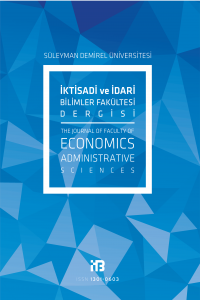LİTERATÜR ARAŞTIRMASI: ALTI SİGMA METODOLOJİSİ
Altı Sigma, Yalın Yönetim, Literatür Araştırması
Literatür Araştırması: Altı Sigma Metodolojisi
-,
___
- J.A.BLAKESLEE, 1999, ‘‘Implementing the Siz Sigma Solution’, Quality Progress, 33, 77-85.
- STAMATIS, D.H., 2003, ‘‘Six Sigma and Beyond Volume VII-The Implementation Process 1th ed.’’, St.Lucie Press, Florida, 95-116.
- PANDE, P. S., NEUMAN, R. P., CAVANAGH, R. R., 2000, “The Six Sigma Way: How GE Motorola anda other top companies are improving their performance, 1th ed.”, McGraw-Hill, New York, 30-42, 55, 60-67, 88-93, 100-350.
- POLAT, A., CÖMERT, B., ARITÜRK, T., 2005, “Altı Sigma Nedir?, 2.baskı”, SPAC Altı Sigma Danışmanlık, Ankara, 15-125.
- GÜR, İ.İ., Ağustos 2003, “Kalite Yönetiminde 6 Sigma Yaklaşımı”, Yüksek Lisans Tezi, Gazi Üniversitesi Fen Bilimleri Enstitüsü, Ankara, 10-22.
- HAHN, G. J, HILL, R. W., ZINKGRAF, S. A., 1999, “The Impact of Six Sigma Improvement –A Glimpse Into the Future of Statistics”, American Statistician, 9: 208-215.
- DESHPANDE, P. B., MAKKER, S. L., GOLDSTEIN, M., 1999, “Boost Compotitiveness via Six Sigma”, Chemicial Engineering Progress, 11: 65-70.
- CHEN, Y. T., ALI, O. G., 1999, “Design Quality and Robustness with Neural Networks”, IEEE Transactions on Neural Networks, 20: 1518 - 1 527 .
- NEVALAINEN, D., BERTE, L., KRAFT, C., LEIGH, E., PICASO, L., MORGAN, T., 2000, “Evaluating Laboratory Performance on Quality Indicators
- Pathology&Laboratory Medicine, 516-519. Six Sigma Scale”, Archives
- of 10. DE MAST, J., SCHIPPERS, W. A. J., DOES, R. J. M. M., VAN DEN HEUVEL, E. R., 2000, “Steps and Strategies in Process Improvement”, Quality and Reliability Engineering International, 301-311.
- WYPER, B., HARRISON, A., 2000, “Deployment of Six Sigma Methodology in Human Resource Function: a case study”, Total Quality Management, 11: 720-727.
- CHAN, K. K., SPEDDING, T. A., 2001, “On-line Optimization of Quality in a Manufacturing System”, International Journal of Production Research, 1127-1145.
- GOH, T. N., 2001, “A Pragmatic Approach to Experimentel Design in Industry”, Journal of Applied Statics, 391-398.
- CALCUTT, R., 2001, “Why is Six Sigma Successful?”, Journal of Applied Statistics, 301-306.
- HOERL, R. W., 2001, “Six Sigma Black Belts:What do they need to know?”, Journal of Quality Technology, 391-406.
- PEARSON, T. A., 2001, “Measure of Six Sigma Success”, Quality Progress, 35-40.
- NEUSCHELER-FRITSCH, D., NORRIS, R., 2001, “Capturing Financial Benefits From Six Sigma”, Quality Progress, 39-44 .
- GROSS, J. M., 2001, “A Road Map to Six Sigma Quality”, Quality Progress, 24-29.
- BREYFOGLE, F. W., CUPELLO, J. M., MEADOWS, B., 2001, “Managing Six Sigma: A Practical Guide to Understanding”, Assessing and Implementing the Strategy That Yields Bottom-Line Success, 13- 15.
- CHOWDURY, S., 2001, The Power of Six Sigma, Subir Chowdhury, Chicago, 25-43.
- CHONGHUN, H., YOUNG-HAK, L., 2002, “Intelligent Integrated Plant Operation System for Six Sigma”, Annual Reviews in Control, 27- 43.
- LINDERMAN, K., SCHROEDER, R.G., ZAHEER, S., CHOO, A.S., 2003, “Six Sigma: a goal-theoretic perspective”, Journal of Operations Management, 21: 193-203.
- BACZWESKI, R. A., 2005, “Four Methods for Improving Performance: A Comperison”, Healthcare Financal Management, 59: 101-102.
- GIJO, E.V., RAO, T. S., 2005, “Six Sigma Implementation-Hurdles and more Hurdles”, Total Quality Management, 16: 721-725.
- BANUELAS, R., ANTONY, J., BRACE, M., 2005, “An Application of Six Sigma to Reduce Waste”, Quality and Reability Engineering International, 25: 553-570.
- internet: www.cityoffortwoyne.org/6sigma.htm, 2005.
- ASLAN, D., DEMİR, S., 2005, “Laboratuar Tıbbında Altı Sigma Kalite
- Yönetimi”, Türk Biyokimya Dergisi, 30: 272-278.
- D’ANGELO, R., ZARBO, R.J., 2007, ‘‘The Henry Ford Production System: Measures of process defects and waste in surgical pathology as a basis for quality improvement initiatives’’, American Journal of Clinical Pathology, 3: 423-429.
- ANTONY, J., KUMAR, M., LABIB, A., 2008, ‘‘Gearing Six Sigma into UK Manufacturing SME’s: Results From A Pilot Study’’, Journal of The Operational Research Society, 4: 482-493.
- ISSN: 1301-0603
- Yayın Aralığı: Yılda 3 Sayı
- Başlangıç: 1996
- Yayıncı: Süleyman Demirel Üniversitesi
RİSK YÖNETİMİNDE RİSKE MARUZ DEĞER YÖNTEMLERİ VE BİR UYGULAMA
Yrd.Doç.Dr.Erhan DEMİRELİ, Prof.Dr.Berna TANER
FİNANSAL BİLGİ SİSTEMİNİN HİSSE SENETLERİNE YATIRIM KARARI ÜZERİNE ETKİSİ: İMKB’de Bir Uygulama
Doç.Dr.İsmail BEKÇİ, Havva ALKAN
Yrd.Doç.Dr.Kürşat ÖZDAŞLI, Yrd.Doç.Dr.Selahattin KANTEN, Öğr.Gör.Pelin KANTEN
İŞ YOĞUNLUĞU TAHMİNİ ve İŞGÜCÜ PLANLAMA: SÜPERMARKET UYGULAMASI
Yrd.Doç.Dr.Ecir Uğur KÜÇÜKSİLLE, Prof.Dr.İbrahim GÜNGÖR
GİZLİ MÜŞTERİ ARAŞTIRMASI: MOBİLYA SEKTÖRÜNDE BİR UYGULAMA
Dr.Erkan ÖZDEMİR, Yrd.Doç.Dr.Umut EROĞLU
MARKA SADAKATİ ÖNCÜLLERİ: ÇALIŞAN KADINLARIN KOZMETİK ÜRÜN TÜKETİMİ ÜZERİNE BİR ÇALIŞMA
Öğr.Gör.Dr.Tülay Korkmaz DEVRANİ
İNGİLTERE’DE MALİYE POLİTİKALARI: KRİZ ORTAMINDA DOLAŞAN KEYNESYEN RUH
LİTERATÜR ARAŞTIRMASI: ALTI SİGMA METODOLOJİSİ
Yrd.Doç.Dr.Ediz ATMACA, S.Şule GİRENES
Doç.Dr.Şeref KALAYCI, Esra ZEYNEL
REKABET ÜSTÜNLÜĞÜNÜN SÜRDÜRÜLMESİNDE YETENEKLERİN ROLÜ: YETENEK YÖNETİM YAKLAŞIMI
